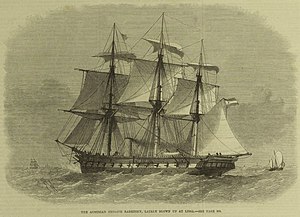SMS Radetzky (1854)
SMS Radetzky era una fragata de hélice de la Marina austrohúngara, construida en Inglaterra en 1856 y perdida por la explosión del polvorín en 1869.
| SMS Radetzky | ||
|---|---|---|
 La fragata austríaca Radetzky | ||
| Banderas | ||
|
| ||
| Historial | ||
| Astillero | Southampton | |
| Tipo | Fragata de hélice | |
| Operador | Armada austrohúngara | |
| Botado | 13 de abril de 1854 | |
| Baja | hundida 20 de febrero de 1869 | |
| Características generales | ||
| Desplazamiento | 2198 t | |
| Eslora | 58,5 m | |
| Propulsión | vapor | |
| Potencia | 300 nhp | |
| Velocidad | 12 nudos | |
| Tripulación | 368 | |

Construcción
editarLa fragata Radetzky fue construida por Money Wigram & Sons de Londres, en sus astilleros de Northam, Southampton. El barco, nombrado en honor al noble y mariscal de campo Joseph Radetzky von Radetz, fue botado el 13 de abril de 1854.[1] Después del equipamiento inicial en Southampton, la fragata navegó por el Mediterráneo, retornando a Inglaterra el 9 de agosto.[2] Subsiguientemente navegó por el río Támesis para la instalación de sus motores de 300 nhp por Maudslay, Sons and Field, que fue completado el 1 de octubre de 1854.[1][3]
Servicio
editarParticipó en la batalla de Heligoland durante la segunda guerra de Schleswig en 1864 y en la batalla de Lissa durante la guerra austro-prusiana en 1866, la primera citada a veces como "el último choque entre barcos de guerra de madera".
Pérdida
editarEn 1869, el polvorín del barco explotó frente a la costa de Vis y se hundió. De una tripulación de 368 hombres, 345 murieron en el incidente.[4] Tras es el redescubrimiento del pecio en 2014, se celebró un servicio conmemorativo, y los nombres de aquellos que perecieron se conservan en la iglesia de Sveti Klement.
Referencias
editar- ↑ a b «Southampton». Evening Mail (13153) (London). 14 de abril de 1854. p. 5. Consultado el 5 de diciembre de 2022 – via British Newspaper Archive.
- ↑ «Nsval and Military Intelligence». The Sun (20013) (London). 11 de agosto de 1856. p. 4. Consultado el 5 de diciembre de 2022 – via British Newspaper Archive.
- ↑ «Military and Naval Intelligence». The Times (22488) (London). 2 de octubre de 1856. p. 10. Consultado el 5 de diciembre de 2022 – via Gale.
- ↑ «The Austrian frigate Radetzky» (Volume: 54 , Issue: 1529). The Illustrated London News. 13 de marzo de 1869. p. 269. Consultado el 18 de abril de 2021. «The terrible disaster which happened on the, 20th ult. to the Austrian frigate Radetzky, by the blowing up of the powder-magazine and total destruction of the ship, while cruising off Lissa, in the Adriatic, has been mentioned in this Journal. Only twenty three men were saved, and most of these had suffered more or less injury. The Radetzky, which was built in England, was a wooden frigate of 1826 tons, 300-horse power, and 30 guns, and had 368 men on board, mostly recruits. This ship took an active part in the fight against the Danes before Heligoland in 1864. She was not engaged in the naval battle of Lissa in 1866, but most of the officers on board were; and Captain Danfalik, who commanded, was there on board the ship Donau».
Bibliografía
editar- Chesneau, Roger; Kolesni, Eugene. Conway's All the World's Fighting Ships 1860–1905. London: Conway Maritime Press. ISBN 0851771335.
- Scotti, Giacomo. Lissa, 1866. La grande battaglia per l'Adriatico. Trieste, Lint. ISBN 8881902117.
- «SMS Graf Radetzky (+1869)». Wrecksite. 4 de junio de 2017. Consultado el 17 de mayo de 2019.
- D. Zeljko Selak (26 de abril de 2014). «Commemoration and scientific conference 'Viški memento' held». hrsvijet. Consultado el 4 de enero de 2021.
- «Last Clash of Wooden Warships: Heligoland 1864». Iron Mike Magazine. Archivado desde el original el 23 de octubre de 2022. Consultado el 4 de enero de 2021.